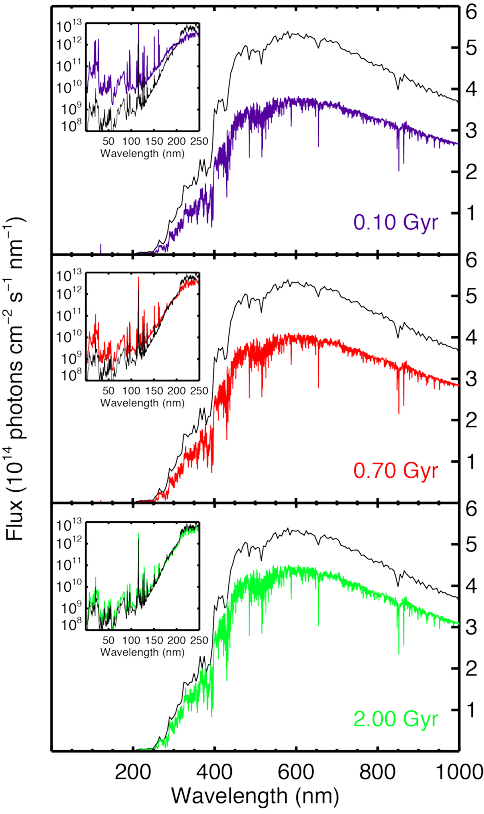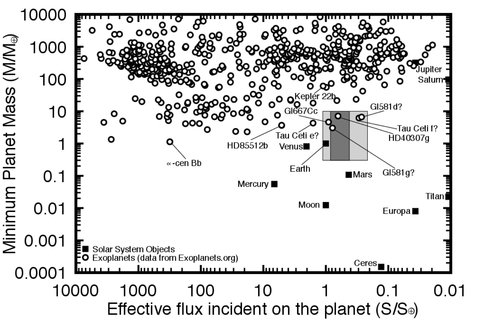2012 Annual Science Report
 VPL at University of Washington
Reporting | SEP 2011 – AUG 2012
VPL at University of Washington
Reporting | SEP 2011 – AUG 2012
Stellar Radiative Effects on Planetary Habitability
Project Summary
Habitable environments are most likely to exist in close proximity to a star, and hence a detailed and comprehensive understanding of the effect of the star on planetary habitability is crucial in the pursuit of an inhabited world. We looked at how the Sun’s brightness would have changed with time providing wavelength-dependent scaling factors for solar flux anywhere in the solar system from 0.6 to 6.7Gyr. Extrasolar planetary systems can only be determined through studying the host star; therefore we have also worked on determining the ages of Kepler planet host stars. We have constructed far ultraviolet to mid-infrared stellar spectra for 44 stars for being used as input in climate and photochemical models that are applied for determining habitable zones and possible characteristics of habitable planets. We have looked into the effect of methane (CH4) and hydrogen (H2) on the outer edge of the habitable zone for F, G, and M stars. We have studied the effect of host star stellar energy distribution (SED) and ice-albedo feedback on the climate of extrasolar planets.
Project Progress
Understanding changes in the solar flux over geologic time is vital for understanding the evolution of planetary atmospheres because it affects atmospheric escape and chemistry, as well as climate. We derived a numerical parameterization for wavelength-dependent changes to the non-attenuated solar flux appropriate for most times and places in the solar system. We combined data from the Sun and solar analogs to estimate enhanced UV and X-ray fluxes for the young Sun and use standard solar models to estimate changing visible and infrared fluxes. The parameterization, a series of multipliers relative to the modern top of the atmosphere flux at Earth, is valid from 0.1 nm through the infrared, and from 0.6Gyr through 6.7Gyr, and is extended from the solar zero-age main sequence to 8.0Gyr subject to additional uncertainties. Data Language (IDL) and FORTRAN codes that calculate relative flux multipliers, as well as estimated solar spectra are available upon request to the first author and via the Virtual Planetary Laboratory Web site at http://depts.washington.edu/naivpl/content/models/solarflux/..
Complete FUV to mid-infrared stellar spectra have been constructed for a subset of 44 nearby stars drawn from the catalog of stars selected by Turnbull et al. (REF) for their relevance as potential targets for characterizing habitable planets. These 44 stars span a broader range of spectral types than the small set of F, G, K, and M dwarfs studied for habitability by Kasting et al. (1993). However, the chief goal is to offer significantly more representatives of F to K stars in order to ensure a robust characterization of the UV flux incident on a planet orbiting such stars, which determines the planetary atmospheric chemistry.
The age of extrasolar planetary systems can only be determined through studying the host star. Stars are born with an initial spin, which then monotonically decreases over their main sequence lifetimes. This stellar rotation plays a central role in generating the stellar magnetic field, whose surface manifestations (starspots and active regions) in turn create observable periodic variability as they rotate into and out of view. Measurements of stellar rotation via variability due to starspots therefore act as a proxy for the stellar age (an otherwise difficult quantity to determine). For planet-hosting stars, this age is the age of the star-planet system. In combination with planetary properties, knowing the system age informs likely surface conditions on terrestrial planets, as well as system architecture and evolution (important for understanding the possible impact history of the system). Using Kepler’s precision photometry, we measured rotation periods and variability characteristics for ~1000 of the Kepler planet candidate hosts (Walkowicz et al. in prep), providing ages for these systems based on existing age-rotation relationships. These measurements reveal that the amplitude of the photometric variability due to starspots can be relatively low even for stars that are rotating rapidly, indicating that some stars may have different size and location distributions of spot over their surfaces. In addition we find that several of the Kepler hot Jupiters have orbits that are synchronized with the spin of the parent star. As tidal synchronization is thought to cause short timescale orbital decay (and therefore destruction) of hot Jupiters, we may be witnessing interaction between the star’s and planet’s magnetospheres in these systems.
Previous studies have shown that the wavelength-dependence of a star’s flux impacts the heating response of planetary atmospheres. Here, we use a 1-D radiative-convective climate model to assess the impact that CH4 and H2 may have on the outer edge of the habitable zone for F, G, and M stars. Our results show that CH4 extends the outer edge of our solar system from 1.7 to 1.98 AU (~14 ), and even further out for F0 stars (~20). In contrast, large stratospheric inversions may actually shrink M star habitable zones for CH4 exceeding ~1%. For H2, the outer edge extends up to ~ 12% for F0 stars and slightly less for G2 (8%) and M3 (6%) stars. The existence of both CO2 and CH4 in the atmospheres of Earth and likely, Mars, suggests that CO2 and CH4 may be a common greenhouse gas combination for biologically-active extrasolar planets in the habitable zone. It is also possible that some hydrogen-rich planets located in the habitable zone are pre-methanogenic worlds waiting to evolve into CH4-rich atmospheres. Both CH4 and H2 are potentially important greenhouse gases for habitable planets and warrant top consideration in future planet-finding missions.
The ice-albedo feedback mechanism is a positive feedback process in which a change in ice cover, due to a warming or cooling trend, alters the albedo of a planet and reinforces the original climate perturbation. Because of the spectral dependence of ice albedo, the behavior of this mechanism is sensitive to the type of stellar radiation incident on a planetary surface. Previous work has implied that planets around M-dwarf stars would demonstrate a suppression in ice-albedo feedback due to ice absorbing strongly at infrared (IR) wavelengths, where M dwarfs emit a significant fraction of their radiation (Joshi and Haberle, 2012). Using a hierarchy of models, we quantified the effect of stellar spectral energy distribution (SED) on the broadband albedo of snow and ice of varying grain size. We demonstrated that M-dwarf planet climates may be much less sensitive to changes in stellar insolation than G- and F-dwarf planets receiving equivalent amounts of flux (assuming fixed CO2), and the interaction between the host star SED and the lower-albedo ice on M-dwarf planets plays an important role in this result, in addition to the increased atmospheric absorption of the much higher near-IR radiation emitted by M-dwarf stars. F-dwarf planets exhibit a stronger ice-albedo feedback, due to the higher visible and near-UV input from F-dwarf stars, where ice reflects strongly. Given that at the outer edge of the habitable zone CO2 can be expected to be much higher in order to maintain clement conditions, we find that ~3-10 bars of CO2 will entirely mask the climatic effect of ice and snow. However, M-dwarf planets appear to maintain surfaces free of global glaciation with larger decreases in stellar flux, essentially existing “snowball-free” at greater distances before increased CO2 would be required to keep the surface habitable.
Predicted solar fluxes at various ages (colored lines), black lines are the (binned) modern Sun (Claire et al. 2012).
Habitable zone limits in terms of stellar fluxes as a function of stellar effective temperatures. Some of the extrasolar planets that are claimed to be in the HZs of their host stars are also shown. These are updated limits to Kasting et al.(1993) results, with new H2O & CO2 absorption coefficients derived from the HITRAN 2008 and HITEMP 2010 line-by-line databases.
Terrestrial planets in the inner box must be in the Habitable Zone (HZ), irrespective of the stellar spectral type. For planets that are outside the dark grey region, but inside the light grey (for example, Earth) one needs to know the host star’s spectral type (or T_eff) to determine if that planet is in the HZ. This figure combines observable stellar and planetary parameters to further constrain HZ boundaries for extrasolar planets.
Publications
-
Claire, M. W., Sheets, J., Cohen, M., Ribas, I., Meadows, V. S., & Catling, D. C. (2012). THE EVOLUTION OF SOLAR FLUX FROM 0.1 nm TO 160 μm: QUANTITATIVE ESTIMATES FOR PLANETARY STUDIES. The Astrophysical Journal, 757(1), 95. doi:10.1088/0004-637x/757/1/95
-
PROJECT INVESTIGATORS:
-
PROJECT MEMBERS:
David Catling
Co-Investigator
Martin Cohen
Co-Investigator
James Kasting
Co-Investigator
Victoria Meadows
Co-Investigator
Norman Sleep
Co-Investigator
Kevin Zahnle
Co-Investigator
Suzanne Hawley
Collaborator
John Sheets
Undergraduate Student
-
RELATED OBJECTIVES:
Objective 1.1
Formation and evolution of habitable planets.
Objective 1.2
Indirect and direct astronomical observations of extrasolar habitable planets.
Objective 2.1
Mars exploration.
Objective 4.1
Earth's early biosphere.
Objective 4.3
Effects of extraterrestrial events upon the biosphere
Objective 7.2
Biosignatures to be sought in nearby planetary systems





